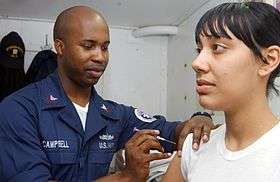Ring vaccination
Ring vaccination is a strategy to inhibit the spread of a disease by vaccinating only those who are most likely to be infected.[1]
| Ring vaccination | |
|---|---|
 A vaccination |
Medical use

When someone falls ill, people they might have infected are vaccinated. Depending on how easily the disease spreads, contacts who could have been infected might include family, neighbours, and friends. Several layers of contacts may be vaccinated (the contacts, the contacts' contacts, the contact's contacts' contacts, etc.).[2]
Ring vaccination thus requires contact tracing, figuring out who a person is likely to infect or have infected. This can be difficult. In some cases, it is preferable to vaccinate everyone within the area in which people have fallen ill (geographically-targeted reactive vaccination). If there is a tight geographic community boundary, it may be preferable to vaccinate the entire community in which the illness has appeared, rather than explicitly tracing contacts.[3]
Many vaccines take several weeks to induce immunity, and thus do not provide immediate protection.[4] However, even if some of the ill person's contacts are already infected, ring vaccination can prevent the virus from being transmitted again, to the ill contacts' contacts. A few vaccines can protect even if they are given just after infection; ring vaccination is somewhat more effective for vaccines providing this post-exposure prophylaxis.[3]
Advantages
When responding to a possible outbreak, health officials should consider which is best, ring vaccination or mass vaccination. In some outbreaks, it might be better to only vaccinate those directly exposed; variable factors (such as demographics and the vaccine that is available) can make one method or the other safer, with fewer people experiencing side-effects when the same number are protected from the disease.[5]
History
Ring vaccination was used in the eradication of smallpox.[6][7]
It was also used experimentally in the Ebola virus epidemic in West Africa.[8][9]
In 2018, health authorities used a ring vaccination strategy to try to suppress the 2018 Équateur province Ebola outbreak. This involved vaccinating only those most likely to be infected; direct contacts of infected individuals, and contacts of those contacts. The vaccine used was rVSV-ZEBOV.[10]
Ring vaccination has been used extensively in the 2018 Kivu Ebola outbreak, with over 90,000 people vaccinated. In April 2019, the WHO published the preliminary results of the research by its research, in association with the DRC's Institut National pour la Recherche Biomedicale, into the effectiveness of the ring vaccination program, stating that the rVSV-ZEBOV-GP vaccine had been 97.5% effective at stopping Ebola transmission, relative to no vaccination.[11][12]
See also
References
- Kucharski, Adam J.; Eggo, Rosalind M.; Watson, Conall H.; Camacho, Anton; Funk, Sebastian; Edmunds, W. John (2016). "Effectiveness of Ring Vaccination as Control Strategy for Ebola Virus Disease". Emerging Infectious Diseases. 22 (1): 105–108. doi:10.3201/eid2201.151410. PMC 4696719. PMID 26691346.
- "Ring Vaccination: Smallpox | CDC". www.cdc.gov. US Centers for Disease Control. 15 February 2019. Retrieved 19 May 2019.
- Walldorf, JA; Cloessner, EA; Hyde, TB; MacNeil, A; CDC Emergency Ebola Vaccine, Taskforce. (7 September 2017). "Considerations for use of Ebola vaccine during an emergency response". Vaccine. 37 (48): 7190–7200. doi:10.1016/j.vaccine.2017.08.058. PMC 5842136. PMID 28890191.
- "Understanding How Vaccines Work | CDC". www.cdc.gov. US Centers for Disease Control. 13 March 2019. Retrieved 19 May 2019.
- Kretzschmar, Mirjam; Wallinga, Jacco; Teunis, Peter; Xing, Shuqin; Mikolajczyk, Rafael (2006-08-01). "Frequency of Adverse Events after Vaccination with Different Vaccinia Strains". PLOS Medicine. 3 (8): e272. doi:10.1371/journal.pmed.0030272. ISSN 1549-1277. PMC 1551910. PMID 16933957.
- Strassburg, M. A. (1982). "The global eradication of smallpox". American Journal of Infection Control. 10 (2): 53–9. doi:10.1016/0196-6553(82)90003-7. PMID 7044193.
- "World on the verge of an effective Ebola vaccine". World Health Organization. Retrieved 31 July 2015.
- James Gallagher (31 July 2015). "Ebola vaccine is 'potential game-changer'". BBC News Health. UK: BBC. Retrieved 30 July 2015.
- Henao-Restrepo, Ana Maria; et al. (31 July 2015). "Efficacy and effectiveness of an rVSV-vectored vaccine expressing Ebola surface glycoprotein: interim results from the Guinea ring vaccination cluster-randomised trial". The Lancet. 386 (9996): 857–866. doi:10.1016/S0140-6736(15)61117-5. hdl:10144/575218. PMID 26248676.
- Aizenman, Nurith (May 15, 2018). "Can The New Ebola Vaccine Stop The Latest Outbreak?". NPR.org. Retrieved 2018-05-16.
- Mole, Beth (2019-04-16). "As Ebola outbreak rages, vaccine is 97.5% effective, protecting over 90K people". Ars Technica. Retrieved 2019-04-17.
- "Ebola Ring Vaccination Results 12 April 2019" (PDF). www.who.int. 12 April 2019. Retrieved 17 April 2019.
Further reading
- "WHO | First Ebola vaccine to be tested in affected communities one year into outbreak". www.who.int. Retrieved 2015-07-31.